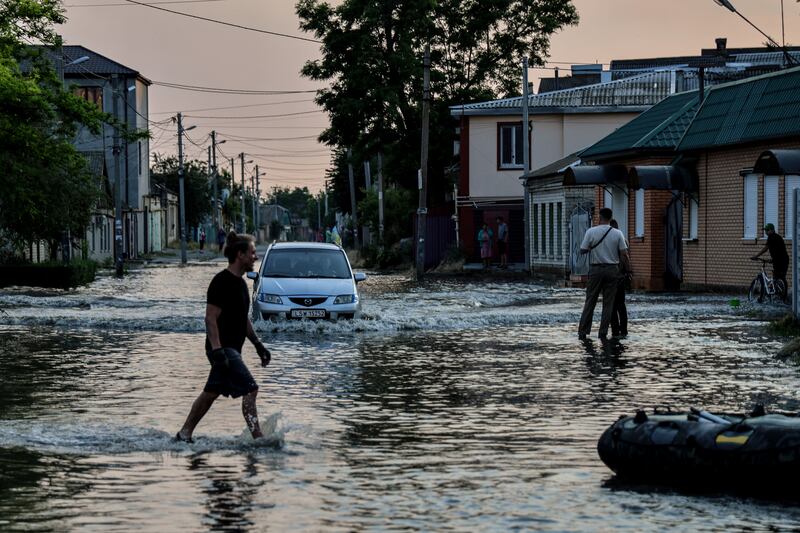On what should have been a Kherson street corner, Larysa Musian, a hydrologist, sits and watches the flood waters rising. The Dnipro River used to be 300 to 400 metres away, but after the dam at Nova Kakhovka was breached at 2.50am on Tuesday, it has burst into the city, flooding the first two or three blocks of the lowest lying quarter.
Every half hour, Musian rises from her stool, carrying a square charcoal grey ruler. The water, she says, is rising “six to eight cm every half hour” and is three metres above where it was before the dam burst. She phones through her figures to colleagues in the regional monitoring centre in nearby Mykolaiv.
“When it goes back to five cm an hour, and then four, we can start saying it has stabilised,” Musian continues, as she returns to her perch. But it is not clear when that will happen, not least because “we cannot say for sure how much water passed the dam, because it was controlled by the Russians”.
For now, the river waters continue to rise visibly, in line it seems with Musian’s calculations, lapping farther up the dry streets, the latest avoidable tragedy to hit a city already blighted heavily by the 15-month war.
As a scientist, what does she think of who did this? “It’s inhumane and dumb,” she says, and the culprits were “Russians who did this deliberately; I’m not thinking it was an accident.”
Not everybody wanted to speak to the Guardian, but those who did knew who to blame – “Muscovites”, another resident said.
The nearest Russian positions are only 2.5km away, and since Ukraine managed to liberate Kherson in November, the invaders have responded with incessant and at times deadly shelling. The low-lying area was already largely deserted and war damage is all too visible. Now it is being flooded in smelly, dirty, oil-coated river water.
On the street corner, the scene unfolding around Musian has a surreal quality. Some residents simply stand and stare. Others say they are confident the waters will recede, although the destruction of the dam is absolute. Children run through the water and play in the summer heat. Meanwhile those driving rescue vans complain that most residents, many of whom are elderly, do not want to leave.

Oleksandr Polozov, a landlord whose family has lived in the city for five generations, first heard the dam had burst at 7am when his brother called him from another low-lying home. They thought, he said, that the water would only rise modestly and they could rescue the situation by piling possessions up high on tables.
“What we realised was that the water was rising above a metre,” he said, and it was necessary to put as much as possible in the car before the water at his brother’s house got too deep. Perhaps when a dam has been in place for 67 years it is hard to imagine how destructive its absence and the force of the 18 cubic kilometres of water behind it can be.
Polozov also complained “there was no sign of any sandbags” or any other flood-prevention measures from the beleaguered local authorities. By then, it was late afternoon, but the reality is that the war will have dramatically eroded Kherson’s civil defence capability. Also worrying the Ukrainian civil authorities is the willingness of the Russians to shell places where people, including rescuers, congregate.
There can be no good time to be flooded, but in the middle of the biggest war in Europe since 1945 must be among the worst. – Guardian




















